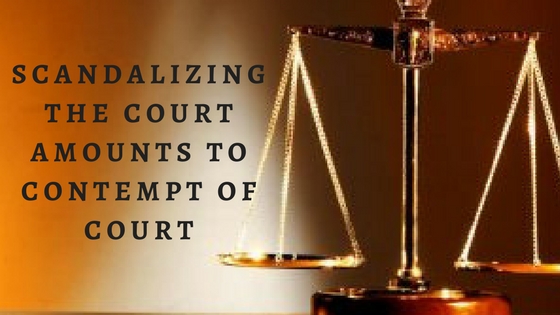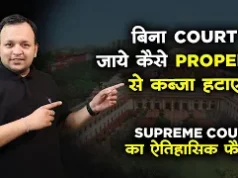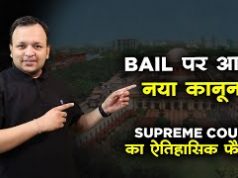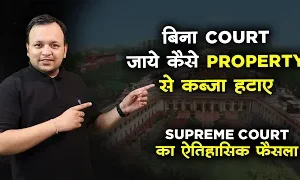Aapka Consultant Judgment Series- In this series, we are providing case analysis of Landmark Judgments of Hon’ble Supreme Court of India.
In Re: Arundhati Roy
AIR2002SC1375, (2002)3SCC343, [2002]2SCR213
Hon’ble Judges/Coram: G.B. Patnaik and R.P. Sethi, JJ.
Date of Decision: 06.03.2002
FACTS:-
The Court in present matter is called upon to deal with the case of the respondent Arundhati Roy, against whom suo motu contempt proceedings have been initiated by this Court. The respondent, who is stated to be an author of name and fame, has landed herself in the dock of the court, apparently by drifting away from the path on which she was traversing by contributing to the art and literature. An organisation, namely, Narmada Bachao Andolan filed a petition under Article 32 of the Constitution of India in this Court. The petitioner was a movement or andolan, whose leaders and members were concerned about the alleged adverse environmental impact of the construction of the Sardar Sarovar Reservoir Dam in Gujarat and the far-reaching and tragic consequences of the displacement of hundreds of thousands of people from their ancestral homes that would result from the submerging of vast extents of land, to make up the reservoir. During the pendency of the writ petition this Court passed various order. By one of the order, the Court permitted to increase the height of the dam to RL 85 meters which was resented to and protested by the writ petitioners and others including the respondent herein. The respondent Arundhati Roy, who is not a party to the writ proceedings, published an article entitled “The Greater Common Good” which was published in Outlook Magazine and in some portion of a book written by her. Two judges of this Court, forming the three-judge Bench felt that the comments made by her were, prima facie, a misrepresentation of the proceedings of the court. It was observed that judicial process and institution cannot be permitted to be scandalised or subjected to contumacious violation in such a blatant manner, it had been done by her. The action of the respondent had caused the court much anguish and when the court expressed its displeasure on the action of the respondent in making distorted writing or manner in which leaders of the petitioner Ms. Medha Patkar and one Dharmadikhari despite giving assurance to the court acted in breach of the injunction. In the instant case cognizance of the criminal contempt against the respondent has been taken by the COURT, suo moto under Section 15 of the Contempt of Courts Act (hereinafter referred to as “the Act”).
ISSUE:-
- Whether proceedings for contempt can be initiated against any person on the ground of his/her allegedly scandalizing the court?
JUDGMENT:-
The judiciary is not only the guardian of the rule of law and third pillar but in fact the central pillar of a democratic State. If the judiciary is to perform it duties and functions effectively and true to the spirit with which they are sacredly entrusted to it, the dignity and authority of the courts have to be respected and protected at all costs. Otherwise the very corner-stone of our constitutional scheme will give way and with it will disappear the rule of law and the civilized life in the society. It is for this purpose that the courts are entrusted with extraordinary powers of punishing those who indulge in acts, whether inside or outside the courts, which tend to undermine the authority of law and bring it in disrepute and disrespect by scandalizing it. When the court exercise this power, it does not do so to vindicate the dignity and honour of the individual judge who is personally attacked or scandalised, but to uphold the majesty of the law and of the administration of justice. The foundation of the judiciary is the trust and the confidence of the people in its ability to deliver fearless and impartial justice. When the foundation itself is shaken by acts which tend to create disaffection and disrespect for the authority of the court by creating distrust in its working, the edifice of the judicial system gets eroded.
No person can flout the mandate of law of respecting the courts for establishment of rule of law under the cloak of freedoms of speech and expression guaranteed by the Constitution. Such a freedom is subject to reasonable restrictions imposed by any law. Where a provision, in the law, relating to contempt imposes reasonable restrictions, no citizen can take the liberty of scandalizing the authority of the institution of judiciary. Freedom of speech and expression, so far as they do not contravene the statutory limits as contained in the Contempt of Courts Act, are to prevail without any hindrance. However, it must be remembered that the maintenance of dignity of courts is one of the cardinal principles of rule of law in a democratic set up and any criticism of the judicial institution couched in language that apparently appears to be mere criticism but ultimately results in undermining the dignity of the courts cannot be permitted when found crossed the limits and has to be punished.
After referring to the definition of criminal contempt in Section 2(c) of the Act, the court found that the terminology used in the definition is borrowed from the English Law of contempt and embodies certain concepts which are familiar to that law which, by and large, was applied in India. The expressions “scandalized”, “lowering the authority of the court,” “interference”, “obstruction” and “administration of justice” have all gone into the legal currency of our sub-continent and have to be understood in the sense in which they have been so far understood by our courts with the aid of English Law, where necessary. Sub-clause (i) of the definition was held to embody the concept of canalization, as discussed by Halsbury’s Laws of England, 3rd Edition in Volume 8, page 7 at para 9. Action of scandalizing the authority of the court has been regarded as an “obstruction” of public justice whereby the authority of the court is undermined. All the three clauses of the definition were held to justify the contempt in terms of obstruction of or interference with the administration of justice. It was declared that the Act accepts what was laid down by the Privy Council and other English authorities that proceedings in contempt are always with reference to the administration of justice. The canalization within the meaning of Sub-section (i) must be in respect of the court or the judge with reference to administration of justice. This Court concluded that the courts of justice are, by their constitution, entrusted with functions directly connected with the administration of justice, and it is the expectation and confidence of all those who have or likely to have business therein that the court perform all their functions on a high level of rectitude without fear or favour, affection or ill-will. It is this traditional confidence in courts of justice that the justice will be administered to the people which is sought to be protected by proceedings in contempt.
Moreover, relying upon some judgments of foreign courts and the cherished wishes expressed or observations made by the Judges of this country it cannot be held as law that in view of the constitutional protection of freedom of speech and expression no-one can be proceeded with for the contempt of court on the allegation of scandalizing or intending to scandalise the authority of any Court. The Act is for more comprehensive legislation which lays down the law in respect of several matters which hitherto had been the subject of judicial exposition. The legislature appears to have kept in mind to bring the law on the subject into line with modern trends of thinking in other countries without ignoring the ground realities and prevalent socio-economic system in India, the vast majority of whose people are poor, ignorant, uneducated, easily liable to be misled.
That apart, fair criticism of the conduct of a judge, the institution of the judiciary and its functioning may not amount to contempt if it is made in good faith and in public interest. To ascertain the good faith and the public interest, the courts have to see all the surrounding circumstances including the person responsible for comments, his knowledge in the field regarding which the comments are made and the intended purpose sought to be achieved. All citizens cannot be permitted to comment upon the conduct of the courts in the name of fair criticism which, if not checked, would destroy the institution itself. Litigant losing in the Court would be the first to impute motives to the judges and the institution in the name of fair criticism which cannot be allowed for preserving the public faith in an important pillar of democratic set up, i.e., judiciary.
The Constitution of India has guaranteed freedom of speech and expression to every citizen as a fundamental right. While guaranteeing such freedom, it has also provided under Article 129 that the Supreme Court shall be a Court of Record and shall have all the powers of such a Court including the power to punish for contempt of itself. Similar power has been conferred on the High Courts of the States under Article 215. Under the Constitution, there is no separate guarantee of the freedom of the press and it is the same freedom of expression, which is conferred on all citizens under Article 19(1). Any expression of opinion would, therefore, be not immune from the liability for exceeding the limits, either under the law of defamation or contempt of Court or the other constitutional limitations under Article 19(2). If a citizen, therefore, in the garb of exercising right of free expression under Article 19(1), tries to scandalise the court or undermines the dignity of the court, then the court would be entitled to exercise power under Article 129 or Article 215, as the case may be. In relation to a pending proceeding before the Court, while showing cause to the notice issued, when it is stated the court displays a disturbing willingness to issue notice on an absurd despicable, entirely unsubstantiated petition, it amounts to a destructive attack on the reputation and the credibility of the institution and it undermines the public confidence in the judiciary as a whole and by no stretch of imagination, can be held to be a fair criticism of the Court’s proceeding. When a scurrilous attack is made in relation to a pending proceeding and the noticed states that the issuance of notice to show cause was intended to silence criticism and muzzle dissent, to harass and intimidate those who disagree with it, is a direct attack on the institution itself, rather than the conduct of an individual Judge. The meaning of the expressions used cannot come within the extended concept of fair criticism or expression of opinion particularly to the case of the contemnor in the present case, who on her own right is an acclaimed writer in English.
HELD:-
On the basis of the record, the position of law and the conduct of the respondent, Court observed that the respondent has committed the criminal contempt of this Court by scandalizing its authority with malafide intentions. The respondent is, therefore, held guilty for the contempt of court punishable under Section 12 of the Contempt of Courts Act. However, showing the magnanimity of law by keeping in mind that the respondent is a woman, and hoping that better sense and wisdom shall dawn upon the respondent in the future to serve the cause of art and literature by her creative skill and imagination, the court decided that the ends of justice would be met if she is sentenced to symbolic imprisonment besides paying a fine of Rs. 2000/-.
To Get Legal Opinion from Advocates/ Legal Experts, Please click here
To Get Legal Opinion from Retired Hon’ble Judges, Please click here












